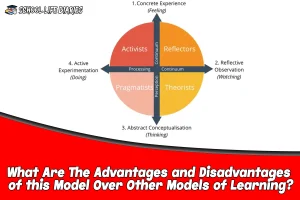The Honey and Mumford learning styles model is a widely used framework for understanding different approaches to learning. Developed by Peter Honey and Alan Mumford, this model categorizes learners into four distinct styles: activists, reflectors, theorists, and pragmatists. Each style represents a unique way of approaching and processing information, with individuals often exhibiting a dominant preference for one or two styles.
The Honey and Mumford questionnaire is the primary tool used to identify an individual’s learning style. By answering a series of questions, participants are able to determine which style(s) best align with their preferred methods of acquiring knowledge and skills. While the Honey and Mumford model has its advantages in promoting personalized learning experiences, it also faces criticism for oversimplifying complex cognitive processes and potentially limiting individuals’ growth by pigeonholing them into specific categories.
Understanding the Honey and Mumford Model
This discussion focuses on the Honey and Mumford Model, which outlines four different learning styles: activists, reflectors, theorists, and pragmatists. Activists are characterized by their preference for hands-on experiences and active participation, while reflectors prefer to observe and contemplate before taking action. Theorists are analytical thinkers who enjoy exploring concepts and theories, whereas pragmatists prefer practical applications and solutions.
1. Activists:
Activists, as identified by Honey and Mumford’s learning styles, exhibit a dynamic approach to learning that involves active experimentation and hands-on experiences. This active engagement allows them to explore different possibilities and discover new solutions. Their enthusiasm for learning also makes them great motivators for others, as they inspire excitement and energy in group settings. Activists may struggle with patience when it comes to long periods of reflection or theoretical discussions. They prefer immediate action and may become restless if there is too much emphasis on theory without practical application. Incorporating group discussions, role-plays, simulations, or field trips can appeal to their desire for action-oriented learning experiences.
It is also beneficial to allow activists some degree of autonomy in choosing how they approach tasks or projects, as this empowers them and taps into their natural drive for freedom. Providing regular feedback and recognition of their contributions can help keep them motivated and engaged throughout the learning process. By creating an environment that values their active participation and encourages their unique learning style, educators can effectively engage activists in meaningful ways that promote growth and development.
2. Reflectors:
Reflectors, as identified by Honey and Mumford’s framework, approach learning with a thoughtful and introspective mindset, emphasizing the importance of reflection and analysis in the learning process. They are individuals who prefer to step back and observe before jumping into action. Reflectors take their time to fully understand a situation or concept before making any decisions or taking any actions.
In the workplace, Reflectors may appear to be slow in taking action compared to other learning styles. However, this is because they value deep thinking and thorough understanding before making any moves. Reflectors have a natural ability to assess situations from different perspectives and consider various possibilities before coming to a conclusion. This can contribute greatly to team dynamics as they bring valuable insights and alternative viewpoints. Self-awareness plays a crucial role for Reflectors in their learning journey. By reflecting on past experiences, Reflectors can identify patterns of behavior or thought processes that hinder their growth and make conscious efforts to overcome them.
Reflectors approach learning with an emphasis on thoughtful analysis and self-awareness. Their preference for stepping back allows them to gather information from multiple angles before taking action. In the workplace, their analytical skills contribute valuable insights to decision-making processes.
3. Theorists:
Theorists, according to Honey and Mumford’s framework, approach learning with a logical and systematic mindset, prioritizing the understanding of underlying theories and concepts. Understanding the model allows theorists to make informed decisions about their learning process. By recognizing their inclination towards theoretical frameworks, theorists can choose learning activities that align with their preferences. They may benefit from lectures or discussions that delve into the foundational principles of a topic. This approach helps them build a solid knowledge base on which they can later rely when faced with new challenges.
On one hand, theorists excel at problem-solving by applying logical reasoning skills to complex situations. Theorists may also struggle with ambiguity or uncertainty since they prefer clear guidelines and established frameworks. Theorists within Honey and Mumford’s learning styles framework approach learning with a logical mindset focused on understanding underlying theories and concepts. Understanding this model allows theorists to tailor their learning experiences accordingly but comes with its own set of advantages and disadvantages.
4. Pragmatists:
Pragmatists, as described in Honey and Mumford’s framework, approach learning with a practical mindset focused on applying knowledge and skills in real-world situations. They are action-oriented learners who value the immediate relevance and usefulness of what they are learning. Pragmatists prefer hands-on activities, problem-solving tasks, and opportunities for experimentation. They thrive in environments where they can actively engage with the material and see how it can be applied to solve practical problems. One of the strengths of pragmatists’ learning approach is their ability to quickly translate theory into practice.
Their practical mindset may lead them to overlook theoretical foundations or deeper conceptual understanding in favor of immediate application. Another challenge for pragmatists is their potential resistance toward abstract or theoretical subjects that do not have an obvious practical application. In terms of preferred learning activities, pragmatists enjoy simulations, case studies, group projects, fieldwork experiences, and any other activity that allows them to directly apply what they have learned in a real-world context. These activities provide tangible outcomes and reinforce their belief that learning should be immediately applicable.
What is the Honey and Mumford Questionnaire?
The Honey and Mumford questionnaire is a widely-used tool in educational settings that aims to identify an individual’s preferred learning style. The questionnaire consists of a series of statements that participants rate according to how well they apply to them. By completing the questionnaire, individuals can gain insight into their own learning preferences and understand how they process information.
One of the main benefits of understanding learning styles through the Honey and Mumford questionnaire is that it allows educators to tailor their teaching methods to better suit their students’ needs. By identifying whether someone leans towards being an activist, reflector, theorist, or pragmatist learner, teachers can create more engaging and effective lesson plans.
For example, activists thrive on new challenges and hands-on activities, while theorists prefer analyzing concepts and discussing theories.
The Honey and Mumford questionnaire serves as a valuable tool in educational settings by identifying an individual’s preferred learning style. Understanding these preferences not only benefits educators by enabling them to design tailored lesson plans but also empowers individuals to take charge of their own education. By applying these insights to practice both inside and outside the classroom setting, learners can optimize their studying techniques and enhance their overall academic performance.
Identifying Your Learning Style
This discussion focuses on the use of the Honey and Mumford Model for Personal and Professional Development. The Honey and Mumford Model is a widely used questionnaire that helps individuals identify their preferred learning style. By understanding one’s learning style, individuals can tailor their approach to learning and development, both personally and professionally.
Using the Honey and Mumford Model for Personal and Professional Development
Applying the Honey and Mumford model for personal and professional development allows individuals to explore their preferred learning styles and adapt their approach accordingly.
This model provides a framework for understanding how individuals learn best, based on four different learning styles: activist, reflector, theorist, and pragmatist. By identifying which style resonates most with them, individuals can leverage this knowledge to enhance their career growth, education, and team dynamics.
In terms of career growth, using the Honey and Mumford model can be instrumental in helping individuals navigate various stages of their professional journey. For instance, activists thrive in dynamic environments that involve action-oriented tasks. Reflectors, on the other hand, prefer taking a step back to analyze situations before making any decisions. They may find success in jobs that involve careful observation and critical reflection.
Theorists enjoy exploring concepts and theories behind different phenomena. Jobs that encourage research or academic pursuits would be well-suited for them. Lastly, pragmatists prefer practical applications of knowledge in real-world settings. They may excel in positions that emphasize problem-solving skills and require immediate action.
Theorists may contribute by providing a theoretical framework for problem-solving, and pragmatists can test and implement the chosen solution in real-world scenarios. The Honey and Mumford model provides a valuable tool for personal and professional development. By understanding one’s preferred learning style and adapting approaches accordingly, individuals can enhance their career growth, educational experiences, and team dynamics. This model serves as a guide to help individuals make informed choices about how they learn best in various contexts.
What Are The Advantages and Disadvantages of this Model Over Other Models of Learning?
The Honey and Mumford model of learning styles offers several advantages compared to other models. It provides a practical framework that allows individuals to identify their preferred learning styles and adapt their learning strategies accordingly.
One limitation is that it oversimplifies complex individual differences by categorizing people into specific learning styles, potentially overlooking the multidimensional nature of learning preferences.
Advantages of Honey and Mumford Model
One significant benefit of the Honey and Mumford model is that it provides individuals with a framework to understand their preferred learning style, which can help them tailor their learning experiences and enhance their overall educational journey. By identifying whether they are activists, reflectors, theorists, or pragmatists, individuals can gain insight into how they best absorb and process information. This knowledge allows them to adapt their study techniques accordingly, making their learning more effective and efficient.
The Honey and Mumford model offers a holistic approach to learning styles by recognizing that people have preferences for both receiving and processing information. Unlike some other models that focus solely on one aspect of learning style (such as sensory modalities), the Honey and Mumford model acknowledges the multifaceted nature of individual learning preferences. This comprehensive understanding enables learners to make informed choices about various aspects of their education, such as selecting appropriate courses or seeking out specific instructional methods.
The advantages of the Honey and Mumford model lie in its ability to provide individuals with a clear understanding of their preferred learning style. By doing so, this model empowers learners to adapt their educational experiences to suit their unique needs, ultimately leading to enhanced academic achievements.
Disadvantages of Honey and Mumford Model
A limitation of the Honey and Mumford model is that it may oversimplify the complex nature of individual learning preferences, as it categorizes individuals into four distinct styles without considering the potential for overlap or variation within each category. While the model provides a useful framework for understanding different learning styles, it fails to acknowledge that individuals can exhibit characteristics from multiple categories or may have preferences that do not neatly fit into one particular style.
Another drawback of the Honey and Mumford model is its reliance on self-reporting, which may introduce bias and inaccuracies in determining an individual’s learning style. This subjective nature of self-reporting introduces limitations in accurately capturing an individual’s true learning preferences.
While the Honey and Mumford model offers valuable insights into different learning styles, it has limitations that need to be considered. Its categorization approach oversimplifies the complexity of individual learning preferences, potentially overlooking variations within each category. Furthermore, its reliance on self-reported data introduces biases and may not capture an accurate representation of an individual’s true learning needs.
Conclusion:
The Honey and Mumford model provides a useful framework for understanding different learning styles. By identifying their preferred learning style through the use of the Honey and Mumford questionnaire, individuals can gain insight into their strengths and weaknesses as learners. This knowledge can then be used to optimize learning experiences and improve overall academic performance.
However, it is important to recognize that the Honey and Mumford model has its limitations. It simplifies complex processes into four broad categories, which may not fully capture the complexity of individual learning preferences. Despite these criticisms, the Honey and Mumford model remains a popular tool for understanding learning styles in educational settings. Its practical approach offers valuable insights for educators and learners alike, facilitating tailored teaching strategies that cater to various learning needs.







